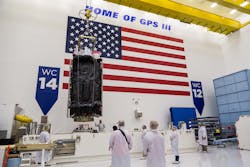Final steps underway to operationalize secure, jam-resistant GPS M-Code signal
COLORADO SPRINGS, Co., – The final steps to fully-enable the ultra-secure, jam-resistant Military Code (M-Code) signal on the Global Positioning System (GPS) are now underway.
As part of the U.S. military’s effort to modernize GPS, the U.S. Space Force has been steadily upgrading its existing GPS Ground Operational Control System (OCS). The Space Force recently announced Operational Acceptance of the GPS Contingency Operations (COps) upgrade, developed by Lockheed Martin (NYSE: LMT). COps enabled control of the operational GPS constellation, now containing 21 M-Code capable GPS satellites, including Lockheed Martin’s first two GPS III satellites, until the next generation OCX ground control system is delivered.
The Space Force’s M-Code Early Use (MCEU) upgrade, delivered earlier this year, will enable the OCS to task, upload and monitor M-Code within the GPS constellation, as well as support testing and fielding of modernized user equipment, prior to the completion of the next-generation ground control systems.
This spring, work will begin to install the components needed to command and monitor the M-Code encrypted GPS signal, which enhances anti-jamming and protection from spoofing, as well as increases secure access for our forces, into the GPS OCS. M-Code signals are currently available on all the on-orbit GPS IIR-M, IIF and III space vehicles.
A key to enabling M-Code is a new software-defined receiver Lockheed Martin developed and is installing at all six Space Force monitoring sites. The M-Code Monitor Station Technology Capability (M-MSTIC) uses a commercial, off-the-shelf general purpose Graphics Processing Unit (GPU) to cost effectively receive and monitor M-Code signals. Operators can monitor the signal as needed. M-MSTIC complements MSTIC’s, which Lockheed Martin developed and fielded to replace aging hardware receivers that were becoming difficult and expensive to maintain.

